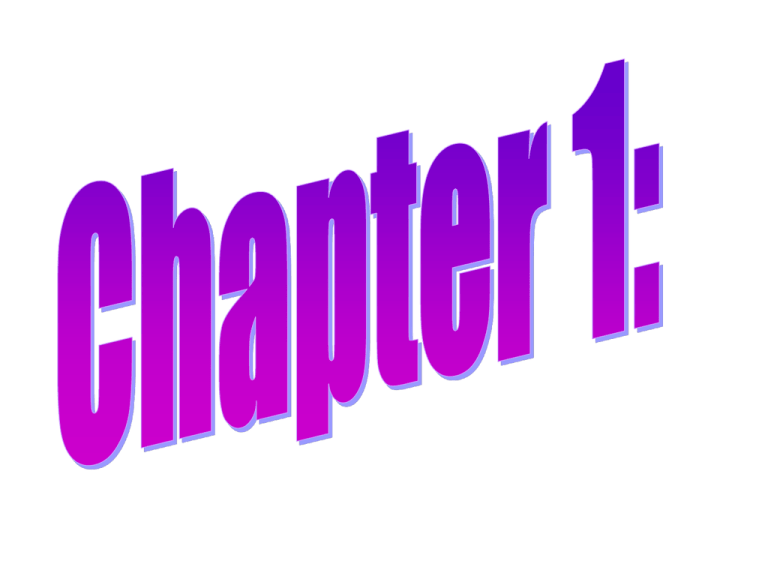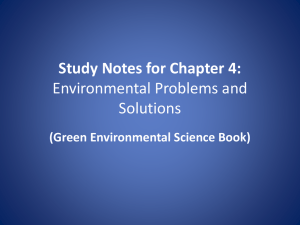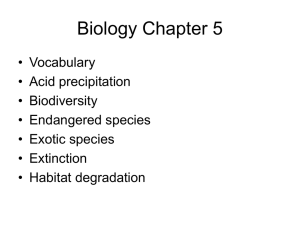Document 15527941
advertisement

I. Scientific Method: Step by step method used to solve problems A. Observations • Facts- Things known to be true • Questions- Solve a problem B. Hypothesis • “educated guess” • Statement about the problem C. Experimentation 1. Reproducible- same results to be obtained by others 2. Controlled experiment- control comparison group experimental group a) Experimental group- variable- one condition which is changed b) Control group- all factors the same c) Double blind study- test subjects & administrations don’t know who is the (exp. group, control group) Data- numerical observations (analyze) D. Conclusions • Support or don’t support the hypothesis E. Theories • Hypothesis that has withstood the test of time II. Biology A. Organization 1. Atoms- smallest particle of matter 2. Molecules- two or more atoms combined 3. Organelles- small functional parts of cells (ex. Ribosomes) 4. Cell- basic unit of life 5. Tissue- group of similar cells (muscle) 6. Organ- group of similar tissues that perform a certain function (liver) 7. Systems- group of organs performing specific functions 8. Organism- living thing 9. Species- interbreeding group of organisms 10. Population- group of same species in a given area 11. Community- group of populations “living things” in a given area 12. Ecosystem: interaction of a community and its surroundings 13. Biosphere- living portion of earth, contains biomes “major climate zones” B. Homeostasis • Ability to maintain a constant internal state a) Endotherms- warm blooded b) Ectotherms- cold blooded I. Ecology: Study of “house” environment A. Populations • • • Size – number of individuals Density – number of individuals per certain area Distribution – location within the area II. Population Growth A. Exponential growth 1. J-shaped 2. Intrinsic rate – rate of growth 3. Birth and death rate – determine population growth 4. Zero population rate – births = deaths B. Logistic growth 1. S-shaped 2. Equilibrium – population stays fairly constant C. Carrying capacity 1. Maximum population density that an area can support 2. Environmental resistance – factors which limit population growth D. Population growth in nature 1. K-selected species – density dependent, population size limited by carrying capacity 2. R-selected species – opportunistic species, population size limited by reproductive rate III. Limiting Factors A. Density-independent factors 1. Environmental changes 2. Natural disasters B. Density-dependent factors 1. Competition – trying for same resources a.) intraspecific – same species b.) interspecific – between different species 2. Predation a.) predator – prey oscillations 3. Parasitism – prey up, parasites up 4. Emigration / Immigration (leave / move into) 5. Disease a.) population up, disease up 6. Cannibalism – eating of own species Survivorship Curves 1. Type I – late loss 2. Type II – constant loss 3. Type III – early loss K R IV.Demography A. Population age structure 1. Age distribution – 5 years (0-4, 5-9) 2. Mortality and survivorship – death rates and ages 3. Fertility – birth rate 4. Age structure and population growth histograms IV. Human Population Growth A. Rate 179 per minute 94 million per year • 1800 – 1 billion • 1930 – 2 billion • 1960 – 3 billion • 1975 – 4 billion • 1987 – 5 billion • 1999 – 6 billion • Malthusian doctrine- 1798 as population increases so do problems. Food supply would run out for humans- Rat experiment B. Future? Carrying capacity? 11 billion • 7 billion (2012 / 2008) 8 billion(2026/2019) C. Controls • Disease – resources - pollution Chapter 27 Community Interactions I. Ecological Communities A. Biodiversity – how many different species 1. Ecological dominants – certain species are more common 2. Keystone species – species that entire community depends on 3. Trophic cascade- keystone species affects all other populations within the ecosystem 4. Nonindigenous species – species not native (examples: Brown tree snake) B. Habitat – environment organism lives in C. Niche – “role” • What is the organisms occupation producers, consumers, decomposers Trophic level II. Symbiosis – coevolution “living together” A. Competition - 1. Trying for the same resources 2. Resource partitioning – live in specific area eat specific organisms 3. Competitive exclusion principle – 2 populations compete for the same limited resources, one will always out compete B. Predation + - • • • Predator eats and kills prey Mimicry – look similar to another species which is usually poisonous preventing being preyed upon Camouflage- blend in to avoid detection C. Parasitism + 1. Host – fed upon 2. Parasite – feeds & lives on host (usually not killed) D. Mutualism + + both organisms benefit Bees and flowers, rhino and oxpecker bird lichen is algae and fungus together E.Commensalism + 0 one benefits one unaffected 1. Host – unaffected 2. Commensal – benefits predators and scavengers epiphytes : plants w/roots in air orchids, bromelaids sharks and remoras III.Succession – predictable change within a community over time Primary succession B. Secondary Succession • Interrupted succession natural disaster or man-made • Will go back to climax community • Quicker than primary succession 2. Water Succesion a) b) c) d) e) Lake – clear water Pond – submergent vegetation Marsh – emergent vegetation – humus Bog – vegetation mat over water Forest Water fills in over time with dead decaying material(humus) which creates less water and more land I. Biotic Factors “Living Factors” A. Autotrophs (Producers) – Plants, “self feeders” can make their own food 1. Photosynthesis – light energy food energy 2. Chlorophyll – green pigment 3. CO2 + H2O C6H12O6 (glucose)+ O2 Light is necessary 4. Provide food for the entire ecosystem 5. Are green and sessile “Other Feeders” B. Heterotrophs (consumers) – can not make their own food 1. Cellular respiration – process by which food is converted to energy (food energy) 2. C6H12O6 + O2 CO2 + H2O + ATP (high energy molecule) 3. Animals 4. Herbivores – eat plants a.) primary consumers – first in food chain b.) leaf eaters, seeds, fruit, and berry 5. Carnivores – meat eaters 6. Omnivores – both plant and meat 7. Saprophytes – non green plant (fungi) feed on dead and decaying material 8. Other feeding techniques a.) liquid feeders – blood & nectar b.) waste feeders – scavengers (eat what they didn’t kill) detritivores – eat wastes C. Decomposers • • “bacteria” break down organic material into it’s simplest form elements C, H, O, N carbon, hydrogen, oxygen, nitrogen II. Food Chains • • Passage of energy through an ecosystem Producer 1st 2nd top Owl Pellets A. Trophic Levels 1. Producer 2. 1st order consumer 3. 2nd order consumer (secondary) 4. 3rd order consumer (tiertiary) – or top order B. Ecological Pyramids – rule of 10 1. Numbers – producers base 2. Energy – most energy to producers, energy is lost thru a food chain 3. Biomass – total amount of living material C. Food Webs all possible feeding relationships in an area III. Ecosystems – community and it’s environment A. Abiotic factors – (nonliving factors) 1. 2. 3. 4. 5. Air – aerobic (need O2) anaerobic (do not need O2) Sunlight – warmth, photosynthesis, vitamin D, sight Temperature – climate (average) weather (day by day) Soil – nutrients (humus), minerals, soil type Water – amount, type (salinity) (brackish) IV. CYCLES A. Carbon cycle 1. respiration CO2 photosynthesis, fossil fuels 2. Carbon decay • Living things C forms chains of carbon B. Nitrogen Cycle 78% of air is N2 NO3 Nitrates – plants use 1. Ammonification – dead decaying organisms, feces & urine – “protein” broken by bacteriaammonia 2. Nitrification – nitrifying bacteria– ammonia(NH4)nitrates( NO3) 3. Dentrification – denitrifying bacteria nitrates N2 4. Nitrogen fixation – N2 (air) Nitrates, legumes have nitrogen fixing bacteria in their roots C. Water Cycle a) Respiration “animals” release water b) Transpiration “plants” release water c) Evaporation “water” d) Water rises as a gas, condenses into liquid Falls to earth as precipitation e) Ground water in Aquifers – underground lakes f) Human use – irrigation, industry, daily needs- all put pollutants back in water V. Current Environmental Problems A. Water Pollution 1. Industrial – chemicals, 50% of all water usage, 23 million septic tanks, 190,000 lagoons 9,000 landfills 2. Surface – runoff, point and nonpoint 3. Groundwater – High Plains aquifer – 20% of all cropland, 200 hazardous chemicals 4. Residential sewage – sewage treatment, primary, secondary, tertiary Most US large cities have secondary plants B. Air Pollution - CO, CO2 (38%) - NO2 (9%) - SO2 (8%) - Particulates (36%) -VOC’s volatile organic compounds (9%) 1. Smog – suspended particles photochemical –yellow / brown, thermal inversions, sunlight + NO2 industrial - grey, dust soot & ash 2. Ozone layer – layer of O3 filters out UV rays, 1995 hole in ozone layer over the Antarctic, CFC’s destroy O3 molecule 3. Acid rain pH 3.5 –5.5 normal rain pH 6-7, burning of fossil fuels, sulfur dioxide combines with water (sulfuric acid) nitrous oxide combines with water (nitric acid) 4. Greenhouse effect – global warming, particulates + CO2 trap in heat, burning of fossil fuels, destruction of forests C. Agriculture a) monoculture – one crop b) chemical fertilizers – nitrates c) irrigation – depletes ground water d) soil erosion – loss of top soil D. Biological Magnification, pesticide and heavy metal amounts increase thru a food chain- increase in the parts per million pesticides – stored in fat Chapter 29 Earth’s Diverse Ecosystems I. Biomes – major climatic regions A. Terrestrial- land 1. Tundra – permafrost “lichen” 2. Taiga – coniferous forest evergreens 3. Temperate forest – deciduous forest maple and oaks 4. Desert – little rain, extreme temps, 32-99 degrees F, cactus 5. Grassland – reduced rainfall, grasses, savannahs 6. Tropical rain forest – high rainfall, high temps, equator, 5 layers, “epiphytes” B. Aquatic 1. Freshwater a.) littoral – near shore b.) photic or limnetic – light, limnetic c.) profundal – bottom, low light oligotrophic – clear lakes, streams, spring fed, little pollution, constant water Eutrophic – increased “humus”, vegetation, sewage, high pollution 2. Estuaries – brackish waters – high in nutrients, salt and fresh water 3. Salt marshes / Mangroves – border oceans, salt tolerant plants and animals Sonneratia tree proboscis monkey Mudskippers epiphytes 4. Intertidal – pockets of water organisms exposed to air 5. Kelp forests – giant algae 6. Coral reefs – breeding grounds for fish 7. Open sea – plankton (base of food chain, rain) II. Habitat Destruction A. Deforestation – removal of trees for lumber, biofuels, slash/burn agriculture Losing 42 million acres per year 40% of worlds rain forests are gone B. Desertification – grasslands desert like, irrigation Chapter 30 Conserving Earth’s Biodiversity What Is Biodiversity? • Biodiversity refers to the variety of living organisms on the planet, including their genes, ecosystems, and community interactions I. Humans and the environment A. Human population growth - exponential, more resources used, more pollution, more habitat destruction B. Industrialization - chemicals, radiation, thermal, synthetics C. Economic growth - money vs. ecology D. Agriculture – unsustainable versus sustainable - monoculture, increased yield, erosion, pesticides, herbicides II. Energy A. Nonrenewable Energy 1) fossil fuels – hydrocarbons( gas, coal, oil) produce CO, CO2, SO2, NO2, and particulates 2) Nuclear power – fission, radioactive wastes, thermal pollution B. Renewable Energy • • • • • • Wind Hydroelectric Solar Trees Garbage – burning Nuclear fusion Extinction • Most biologists believe that human activities are now causing a sixth mass extinction • The current extinction rate is 100 to 1000 times the background rate predicted in the absence of people Many species may have become extinct before being discovered, as suggested by two newly described species The Australian snubnose dolphin and the Aftrican kipunji monkey Only about 1000 of each remain Both are threatened by human activity and might have become extinct before discovery Threatened Species • Increasing numbers of species are threatened with extinction • Depending on the likelihood of extinction in the near future, threatened species are described as critically endangered, endangered, or vulnerable As of 2004 there are 15,589 threatened species 12% of all birds 23% of all mammals 32% of all amphibians 42% of all turtles and tortoises Threats to Biodiversity • Two processes are fueling the decline in Earth’s biodiversity – Increasing use of resources to support human lifestyles – Human activities that destroy habitats and pollute the environment Humans threaten biodiversity in a number of ways Habitat destruction Overexploitation Harmful interaction with invasive species Pollution Global warming Habitat Destruction • Other activities that lead to habitat destruction – Damming rivers – Draining wetlands – Building roads and housing – Industry Some species need thousands of acres to find food and breed Habitat fragmentation threatens wildlife by splitting up natural ecosystems Invasive Species • When non-native species are introduced into an area, they can becomes invasive • Invasive species can displace native species and disrupt community interactions through – Competion for food and/or habitat – Direct predation Island and lake communities are particularly vulnerable to invasive species The mongoose, imported to Hawaii to control rats, now threatens birds The Nile perch, introduced to Lake Victoria for fishing, now threatens 200 other species Pollution • Pollutants that threaten biodiversity include synthetic chemicals – Plasticizers, flame retardants, pesticides • Enter air, water, soil • Accumulate in animal tissues, disrupting development or reproduction Accumulation of high levels of some natural substances are also threats Mercury, lead, and arsenic from mining and manufacturing are toxic Oxidized nitrogen and sulfur released by burning fossil fuels lead to acid rain Global Warming • Leads to habitat destruction • Rapid pace of global warming taxes abilities of species to adapt to changing conditions through natural selection • By 2050: estimated that 1 million species will be threatened with extinction due to global warming Human Population Growth • 75-80 million people are added to the planet every year • Growth rate is incompatible with a sustainable increase in quality of life for the present 6.5 billion inhabitants Lifestyle and Technologies • Changes that humans can make to develop sustainable approaches – Make responsible reproductive choices – Reduce energy consumption and use of fossil fuels – Develop and use energy-saving technologies – Rely on renewable energy sources – Make consumer choices that promote sustainable practices







